Programming STM32 (BluePill) Via Arduino for Beginners
by drmpf in Circuits > Arduino
26322 Views, 8 Favorites, 0 Comments
Programming STM32 (BluePill) Via Arduino for Beginners
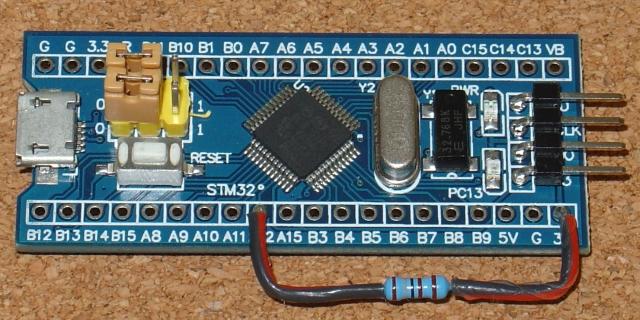
Contents
Parts List
Preparing the “BluePill” -- Step 1
Preparing the ST-Link V2 -- Step 2
Installing the STM32 Arduino IDE add on -- Step 3
Installing the SafeString Library for the millisDelay class -- Step 3
Tools Menu Settings -- Step 4
Programming with STM32CubeProgrammer and ST-Link V2 -- Step 5
Programming via the HID bootloader -- Step 6
Programming via the Maple bootloader -- Step 7
Installing the Maple Drivers -- Step 7
Programming the “BluePill” as a USB to Serial Converter -- Step 9
Wiring up the USB to Serial connection -- Step 9
Introduction
This project programs an inexpensive “BluePill” (STM32F103C8) board as a USB to Serial (115200) converter using the Arduino IDE. One of the complications of programming STM32 boards is, in addition to the various code tools, is the myriad ways the compiled code can be uploaded to the board. This project covers three methods. They all use an inexpensive ST-Link V2 clone as part of the setup to program STM32 cpu's via the Arduino IDE.
This project is a addendum to the Very Low Power BLE project which is being revised to use currently available programming tools and nRF52 modules. That project uses an in-expensive ST-Link V2 / BluePill combination to build an CMSIS-DAP replacement programmer. What was lacking was a means of displaying the BLE modules Serial debug msgs on the computer. This project fore fills that role for an addition few $'s and uses the same micro USB cable.
This project, like the revised Very Low Power BLE project, avoids source code builds (which are messy on Windows) for the various tools needed. The bootloaders used are pre-compiled bins and the ST-Link V2 is driven by the STM32CubeProgrammer. While this project was completed on a Windows 7 machine, the Arduino IDE and STM32CubeProgrammer are available for Windows 32 and 64 and Mac and Linux as well and so at least the first programming method should also work for those machines. In second method the USB connection looks like a USB Input Device and so should work on Mac and Linux as well. The third method needs a Maple COM driver. Tested on Windows 7 only.
Scanning through this project you may well decide that unless you really want to program STM32 boards, this process just has too many steps to be worth the effort to avoid buying a ready made USB to Serial converter for US$6 or less.
Supplies
ST-Link V2 clone – ~US$2.75 from Aliexpress
“BluePill” STM32F103C8 clone – ~US$2.75 from Aliexpress Note: Purchase the C8 version not the slightly cheaper C6 and a PC13 pcb version as marked in the photo above on the right near B8 B9
USB A to Micro USB cable – ~US$1 from Aliexpress
1 x 1K8 1/2W metal film resistor – US$1 (8off) from Jaycar RR0578 or Aliexpress
Arduino IDE and the STM32 V2.2.0 addon installed via the IDE board manager
STM32CubeProgrammer – free with registration
For the USB to Serial Converter
2 x 1K 1/2W metal film resistor – US$1 (8off) from Jaycar RR0572 or Aliexpress
2 x Female to Male Jumper Wires – US$1.5 from Aliexpress
Heat Shrink tubing to suit resistors (3mm dia) – US$2 from Jaycar WH5532 or Aliexpress
STM32_Serial1Passthrough.ino This Arduino sketch needs the following library to be installed via the Arduino IDE Library Manager:- SafeString V4.1.14+
Alternative Programming Methods
hid_generic_pc13.bin (zipped) HID bootloader from https://github.com/Serasidis/STM32_HID_Bootloader
OR
generic_boot20_pc13.bin (zipped) Maple bootloader from https://github.com/rogerclarkmelbourne/STM32duino... maple_drivers.zip – Drivers for the Maple bootloader from https://github.com/rogerclarkmelbourne/STM32duino...
Total cost, as at Feb 2022, excluding shipping – ~US$12. However most of these components were already purchased for the Very Low Power BLE project (if you are doing that project) so the only real extra cost was the additional “BluePill” ~US2.75, which is why this method is being used to create a USB to Serial converter.
Preparing the “BluePill”
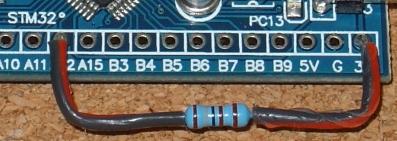
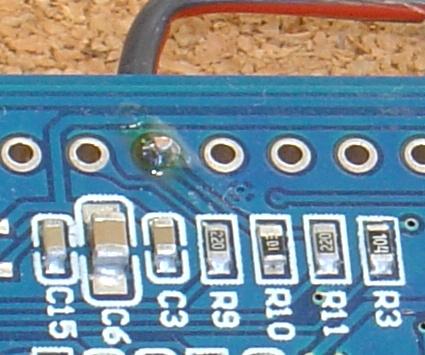
The STM32F103C8 “BluePill” has a common circuit error. The pullup resistor on the USB line running to A12 should be 1K5, but is often 10K on the boards supplied. You can check this by looking at the R10 resistor on the back of the board.
If the R10 marking 103, as shown above, then the board has the incorrect 10K resistor fitted. If it is marked at 152, then the board has the correct 1K5 resistor fitted.
Boards with the incorrect R10 (103) resistor can be fixed by wiring a 1K8 resistor from A12 to 3v3 as shown here.
Preparing the ST-Link V2
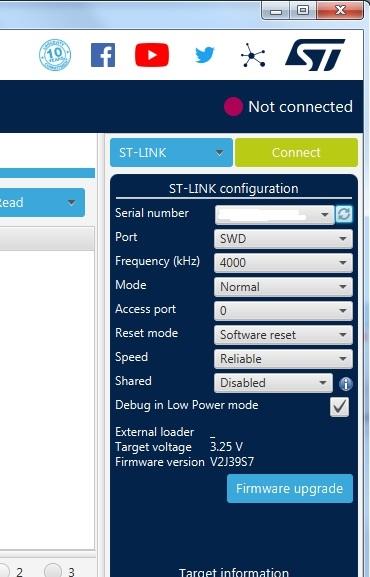
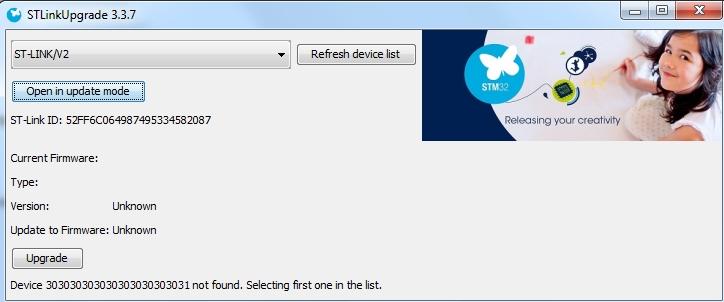
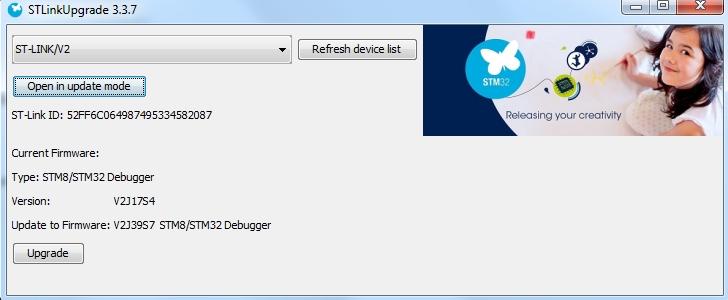
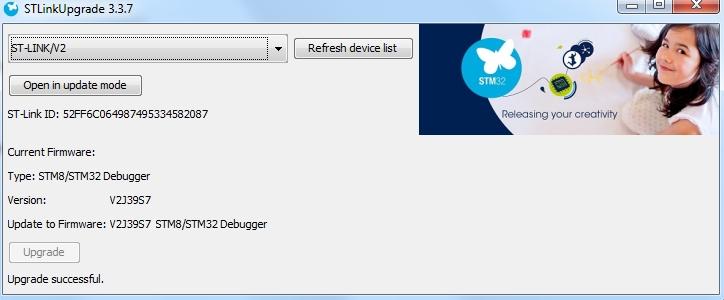
BEFORE YOU START: Create a restore point on your PC so that you can undo all the driver/program installs that STM32CubeProgrammer install and other steps makes. Search “create a restore point” in the Start menu. Note: Recovering to a previous restore point can delete new .ino files you have created so back them up first
With the ST-Link V2 not plugged in, download and install the STM32CubeProgrammer. This installs a number of drivers as well. Plug in the ST-Link V2 and see its driver installed (after a while)
Open STM32CubeProgrammer. In the Serial number you will most likely see Old Software need to upgrade and an Error old firmware upgrade message.
- Click on the Firmware upgrade button.
- Click Refresh device list and then Open in update mode. You may be prompted ST-link is not in the DFU mode. Please restart it. Remove and re-insert the ST-Link V2 to restart it.
- You can then click the Upgrade button.
After the upgrade completes you will see Upgrade successful. Close this window to go back to the STM32CubeProgrammer. Refresh the Serial No to see the upgraded ST-Link serial number. The ST-Link is now ready to use to upload programs.
Installing the STM32 Arduino IDE Add On
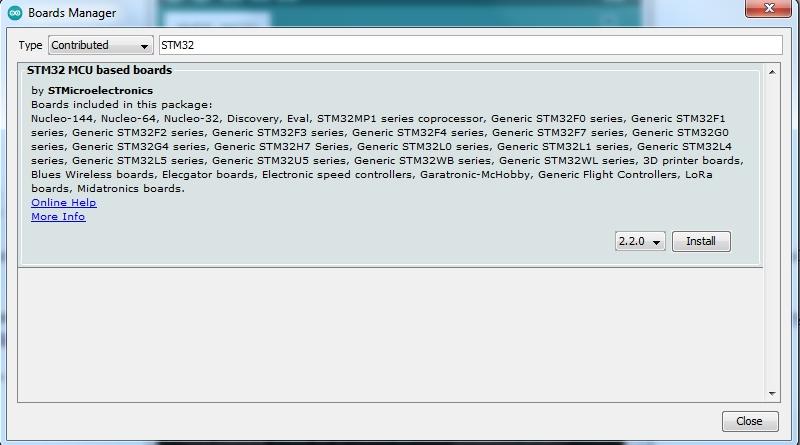
Recommended: Rename your existing Arduino15 folder, to say Arduino15_org, so that you can go easily swap the STM32 addon in and out of Arduino. The location of the Arduino15 folder is shown at the bottom of the File->Preferences window. Arduino will re-create an empty Arduino15 folder if it is missing.
Install Arduino IDE and start it. Open the File → Preferences window and copy this URL (below) into the Additional Boards Manager URL field (see https://github.com/stm32duino/wiki/wiki/Getting-Started)
https://github.com/stm32duino/BoardManagerFiles/ra...
Close the Preference window and open Tools → Board: Arduino Uno → Boards Manager Choose Type: contributed and search for STM32 and Click Install for V2.2.0. It will take a while.
Installing the SafeString Library for the millisDelay class
The STM32_Serial1Passthrough.ino sketch uses the millisDelay class to flash the led as data is sent/recieved.
Open Tools → Manage Libraries and type in safestring to find the SafeString library (takes a few seconds to search) and install it.
Tools Menu Settings
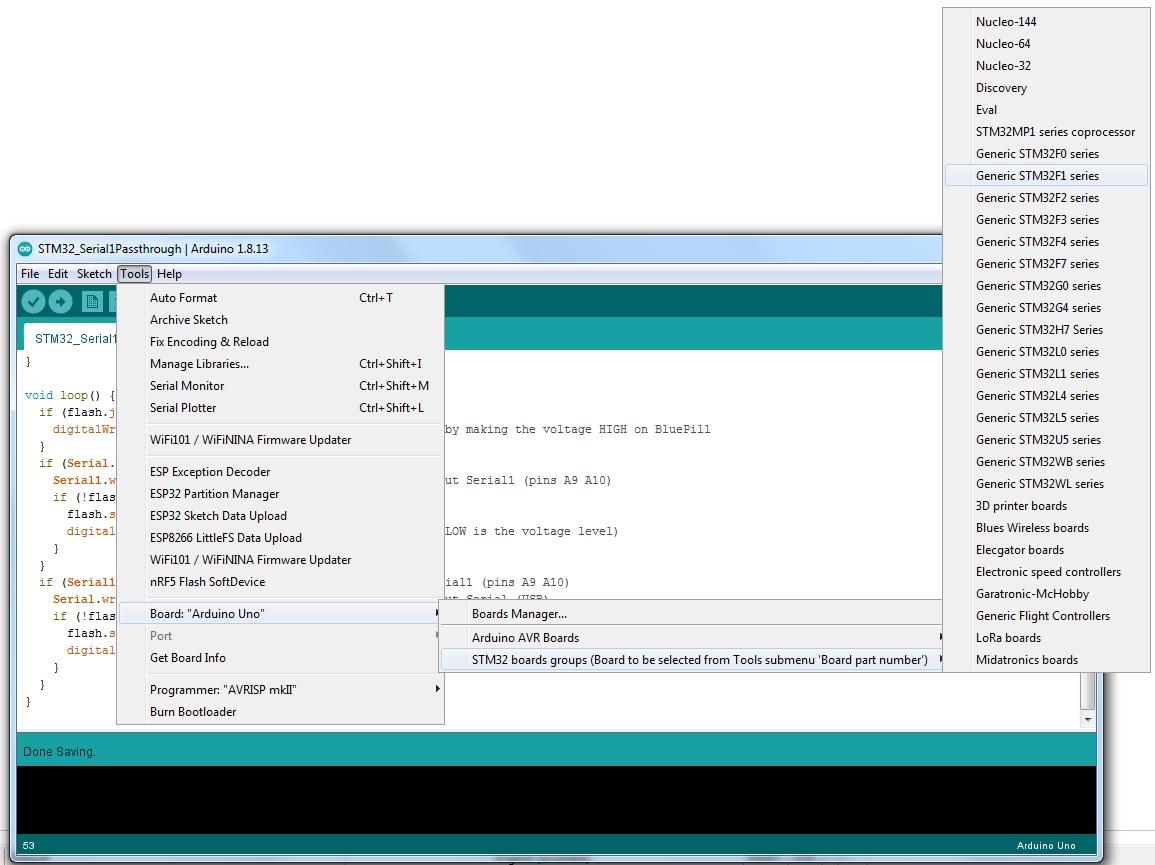
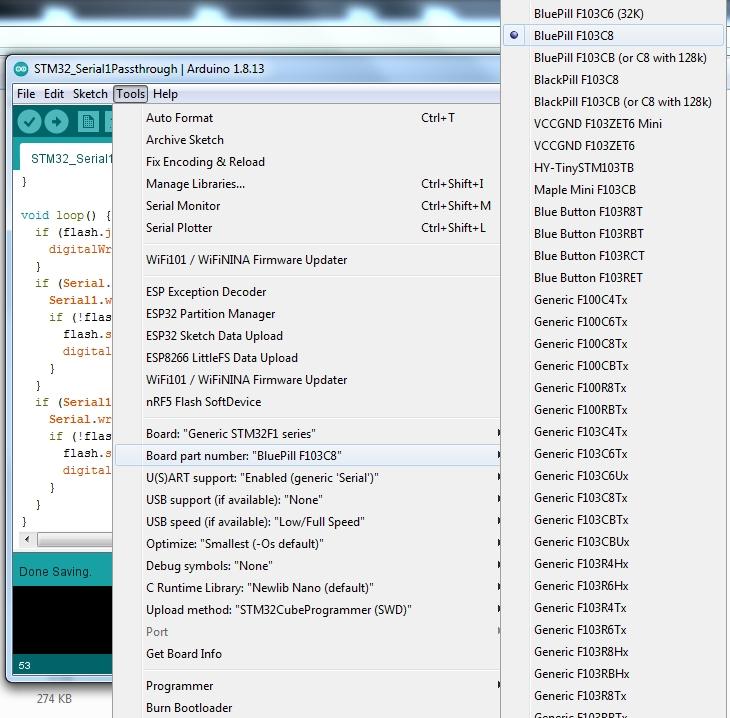
To program the “BluePill” you need to set it in the Tools Menu
Open the Tools → Board: … and choose the STM32F1 series option
Then for Board part number: select BluePill F103C8
Also select USB support (if available): "CDC (generic 'Serial' supersede U(S)ART)" << very important for the USB to Serial sketch
You also need to set an Upload method: which will be different for each of the three methods below.
Programming With STM32CubeProgrammer and ST-Link V2
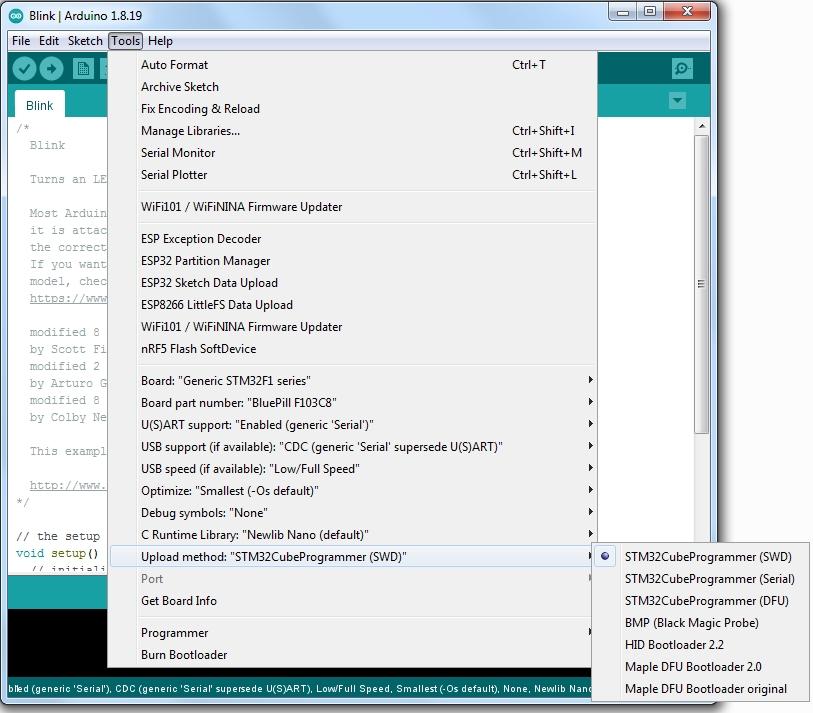
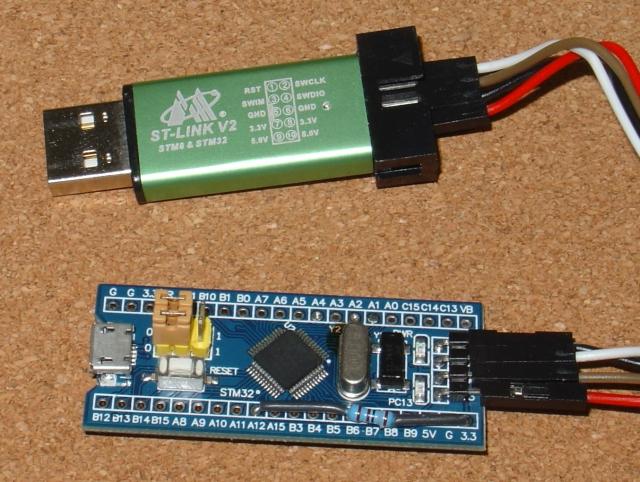
The first Arduino IDE programming method uses the STM32CubeProgrammer and the ST-LinkV2 and is the simplest (provided is works!)
Open the Arduino IDE and open the Examples → Basic → Blink sketch.
Carefully set the Tools Menu settings, as described above in Tools Menu Settings, and then to upload via the STM32CubeProgrammer and ST-Link V2, choose STM32CubeProgrammer (SWD) as the Upload method:
Connect the ST-Link to the “BluePill” header as shown above. (Important: The order of the
ST-LINK V2 GND,SWDIO and SWCLK pins can be different to what is shown in the photo below. CHECK the order on your ST-LINK V2 clone carefully)
ST-Link V2 ↔ “BluePill”
SWDCLK ↔ SWCLK
SWDIO ↔ SWO
GND ↔ GND
3.3V ↔ 3V3
Recheck your connections! Note carefully the Red wire goes to 3V3 on both ends and ALL the wires on
the ST-Link are connected to the second row of pins.
Note: Boot0 and Boot1 jumpers are both set to the 0 side as shown above
Plug in the ST-Link V2 and click the compile/upload button. The STM32CubeProg_BlinkUpload.txt file has a sample Arduino IDE upload output.
The Green led will start blinking.
You can program the STM32_Serial1Passthrough.ino the same way. Open a new sketch and replace its code with the contents of STM32_Serial1Passthrough.ino and save the sketch as STM32_Serial1Passthrough. Then see Wiring up the USB to Serial connection below
If the upload fails, check that the STM32CubeProgrammer is installed in the 'default' install directory and also see see https://github.com/stm32duino/wiki/wiki/Upload-me...
Programming Via the HID Bootloader
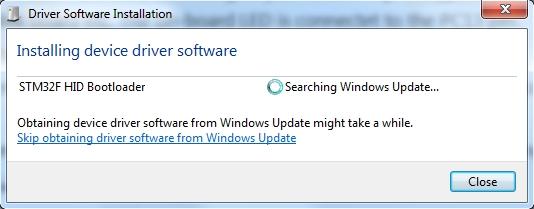
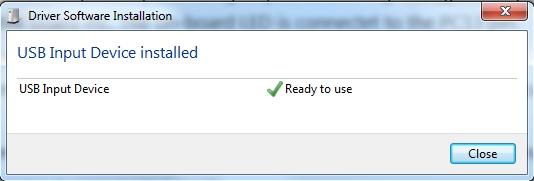
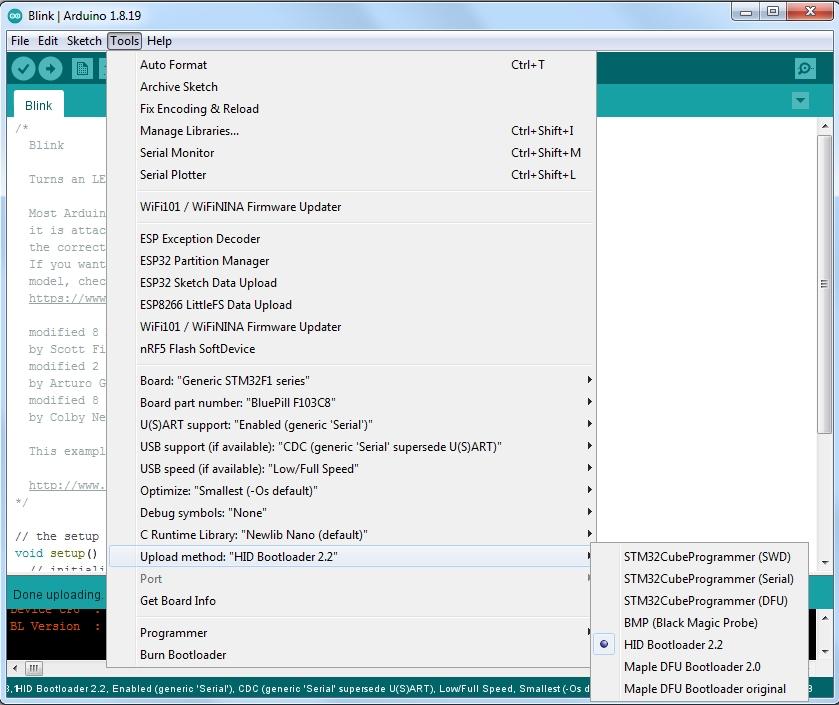
It can sometimes be convenient to do uploading via the “BluePill” USB connection. This next method installs a HID bootloader into the BluePill and there after programs it via the USB socket.
Connect the ST-Link V2 to the BluePill as shown above in Programming with STM32CubeProgrammer and ST-Link V2.
Note: Both Boot0 and Boot1 jumpers are set at 0.
Download and unzip hid_generic_pc13.zip to get the hid_generic_pc13.bin file. Open STM32CubeProgrammer and load the hid_generic_pc13.bin, plug in the ST-Link V2 and download the file into the “BluePill”
Unplug the ST-Link V2 and remove it from the “BluePill” header. Plug in the “BluePill” USB connection.
A USB Input Drive will load (eventually)
Unplug and replug in the USB cable. The Green led on the “BluePill” will come on and stay on.
Open the Arduino IDE and open the Examples → Basic → Blink sketch.
Carefully set the Tools Menu settings, as described above in Tools Menu Settings, and then to upload via the HID bootloader, choose HID Bootloader 2.2 as the Upload method:
Click the compile/upload button to program the Blink example. The Green Led will blink.
You can program the STM32_Serial1Passthrough.ino the same way. Open a new sketch and replace its code with the contents of STM32_Serial1Passthrough.ino and save the sketch as STM32_Serial1Passthrough.
Then see Wiring up the USB to Serial connection below.
Programming Via the Maple Bootloader
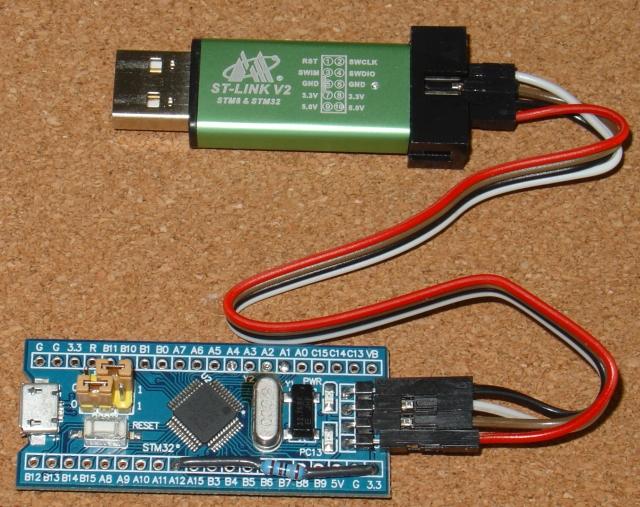
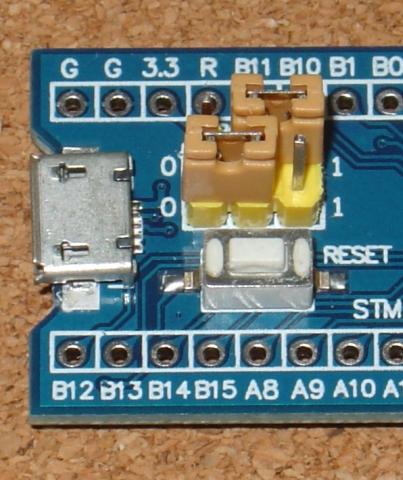
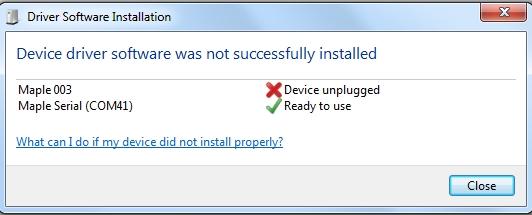
Another alternative programming method, via USB, is to use the Maple bootloader. This need special Maple drivers. The driver install worked will on Windows 7 but may be problematic on other OS's.
Connect the ST-Link to the “BluePill” header as shown above.
ST-Link V2 ↔ “BluePill”
SWDCLK ↔ SWCLK
SWDIO ↔ SWO
GND ↔ GND
3.3V ↔ 3V3
Recheck your connections! Note carefully the Red wire goes to 3V3 on both ends and ALL the wires on the ST-Link are connected to the second row of pins.
Note: Boot0 jumpers is set to 1 while the Boot1 jumpers is left on the 0 side as shown above
Plug the ST-Link V2 back into the computer. Check is shows up on the STM32CubeProgrammer. Refresh the Serial No field if needed.
Download and unzip generic_boot20_pc13.zip file and load the generic_boot20_pc13.bin file. Open STM32CubeProgrammer and load the generic_boot20_pc13.bin, plug in the ST-Link V2 and download the file into the “BluePill”
Unplug the ST-Link V2 and remove it from the “BluePill” header. The Maple drivers need to be installed before plugging in the “BluePill” USB
Move the Boot0 jumper back to 0
Installing the Maple Drivers
Unplug the ST-Link V2 and remove the wires between the “BluePill” and the ST-Link V2.
Set the Boot0 link back to 0
Important: Install the Maple Drivers BEFORE plugging the “BluePill” into the computer for the first time.
Unzip maple_drivers.zip to a convenient directory. Open a cmd prompt (type cmd into the Windows Start search) and cd to the drivers/win directory and run the
install_drivers.bat
That will install two drivers Maple DFU and Maple Serial.
The plug the “BluePill” into the computer. After a long time the Maple Serial driver will be installed. Ignore the Maple 003 device unplugged msg.
Programming the “BluePill” As a USB to Serial Converter
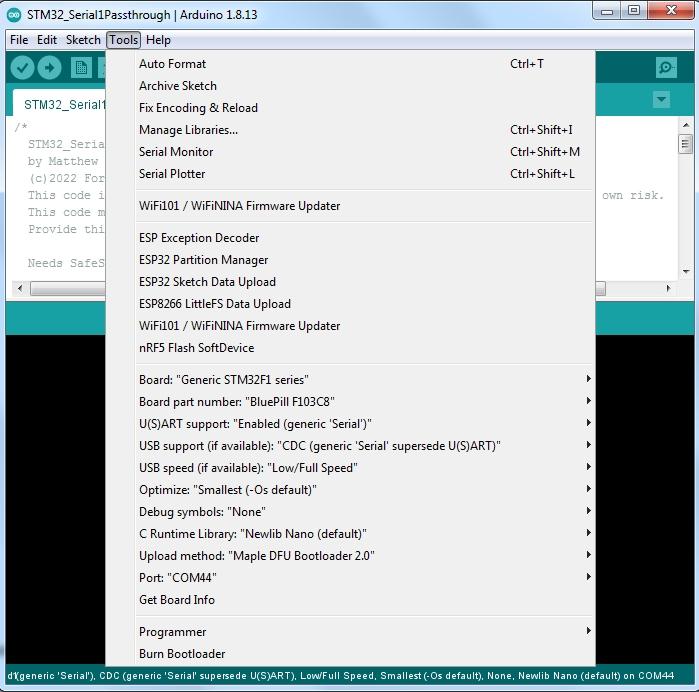
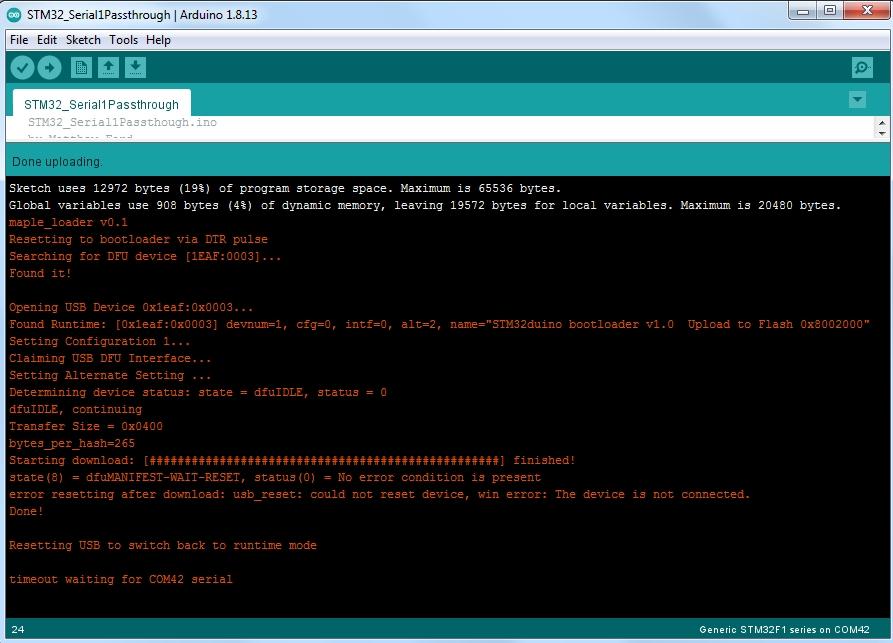
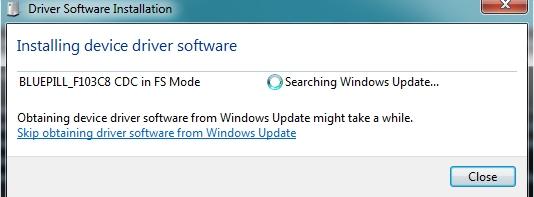
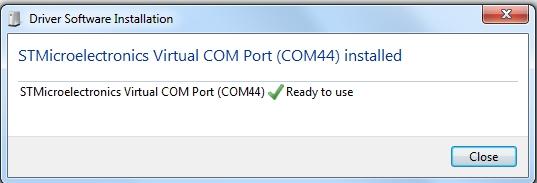
For this programming example the USB to Serial (115200) converter code will be uploaded.
Open a new sketch and replace its code with the contents of STM32_Serial1Passthrough.ino and save the sketch as STM32_Serial1Passthrough.
Carefully set the Tools Menu settings, as described above in Tools Menu Settings, and then to upload via the Maple bootloader, choose Maple DFU Bootloader 2.0 as the Upload method: and set the Port: to the Maple Serial Com port , e.g. COM44
The Tools menu should look like above.
Click the Upload button to compile and upload the sketch to the “BluePill”
If you get a message (in Red) like
Couldn't find the DFU device:
Then start the upload again and this time when the screen shows
Searching for DFU device
Press the “BluePill” reset pushbutton to get into DFU mode. At the end of the upload you may see the following error which you can ignore.
Resetting USB to switch back to runtime mode error resetting after download: usb_reset: could not reset device, win error: The device is not connected.
Once the upload is complete the STM Virtual COM port driver will be installed to access the USB side of the USB to Serial Converter
Wiring Up the USB to Serial Connection
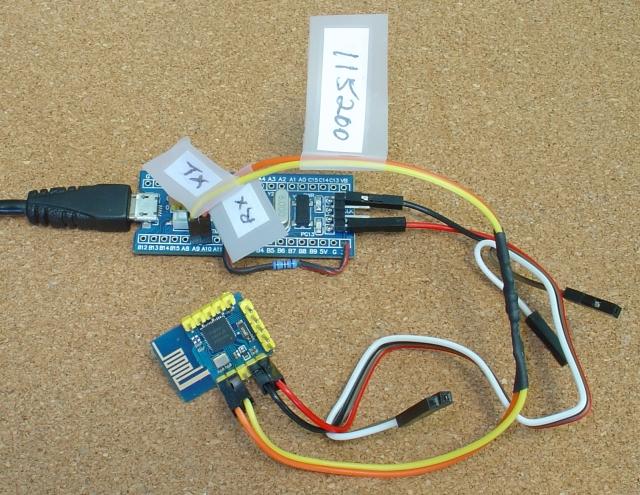
The “BluePill” Serial1 Tx pin is A9 and the Rx pin is A10. Solder two male jumper wires into these pins and cut the wires and solder in a 1K resistor in each. These 1K resistors protect against shorting a Tx output to a Tx output and protects against miss-matches in supply volts between the “BluePill” and the target.
You can also power the target from the “BluePill” The 3V3 / Gnd header pins can supply ~250mA
Unplug and re-plug in the “BluePill” to get a USB to Serial converter running at a fixed 115200 baud on the Serial side. Open COM44 in the Arduino Monitor or a terminal program like TeraTerm or CoolTerm The Yellow led (PC13) will flicker whenever data is passing through the “BluePill”
Conclusion
The project covered how to setup Arduino to program the “BluePill” STM32F103C8 using an ST-Link V2, Three methods of programming were described. The STM32CubeProgrammer via ST-Link V2 is the simplest. As an example program a USB to Serial (115200) converter was uploaded. This USB to Serial converter was for use to debug the nRF52832 modules used in the Very Low Power BLE project